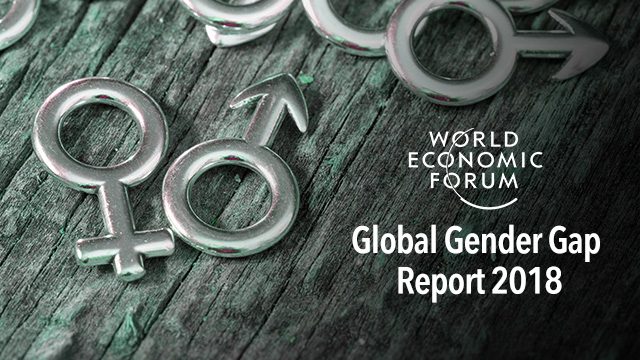SUMMARY
This is AI generated summarization, which may have errors. For context, always refer to the full article.

MANILA, Philippines – There were “marginal improvements” in the fight for gender equality around the world in 2018, according to a World Economic Forum (WEF) report released on Tuesday, December 18.
The Global Gender Gap Report 2018 released on Tuesday, December 18, showed global performance in sealing the gender equality gap remaining at 68% from last year, when the overall index dropped for the first time since WEF launched the report in 2006.
“The directionally positive average trend registered this year is supported by improvements in 89 of the 144 countries covered both this year and last year,” WEF said.
The WEF measures how much countries have been able to close the gender gap based on 4 categories: educational attainment, health and survival, economic opportunity, and political empowerment.
What happened: In 2018, the widest gap continued to be seen in political empowerment where performance continued to lag at 23%, and economic participation and opportunity remained stalled at 58%.
The WEF attributed this to the fact that there were just 17 countries that had women as heads of state. Globally, only 18% of ministers or senior government officials and some 24% of parliamentarians or lawmakers were women.
The WEF said gender gaps in education and health also widened in 2018, but the remained considerably narrower with indices at 96% and 95%, respectively.
It also said countries worldwide “still have a long way to go” when it comes to economic leadership. Only 34% or 3 of 10 managerial positions were held by women across countries with available data, WEF said.
The economic opportunity indicator was the only one to show improvement. The WEF said this was due to a narrower gap in income between men and women, and the number of women who passed leadership roles.
Overall though, the improvement here would do little to change the overall gender gap. The WEF said declining women’s participation in politics and stagnation in the proportion of women in the workplace offset improvements seen in the number of women in professional positions and wage equality.
With the latest results, WEF founder and executive chairman Klaus Schwab urged countries to push for efforts that would contribute to gender equality should they wish to succeed in the “Fourth Industrial Revolution.”
The WEF defines this as a digital revolution that is characterized by a “fusion of technologies that is blurring the lines between the physical, digital, and biological spheres.”
“Proactive measures that support gender parity and social inclusion and address historical imbalances are therefore essential for the health of the global economy as well as for the good of society as a whole,” Schwab said.
Global performance: The 2018 report reviewed 149 counties as part of its rankings. The top 10 most gender equal countries are:
- Iceland
- Norway
- Sweden
- Finland
- Nicaragua
- Rwanda
- New Zealand
- Philippines
- Ireland
- Namibia
The WEF said Western Europe remained as the region with the highest level of gender equality, as it only 24.2% away from closing its gender gap. North America followed, with 27.5% away from closing its gender gap.
Latin America and the Caribbean came next with an average remaining gender gap of 29.2%. It was followed by Eastern Europe and Central Asia with an average remaining gender gap of 29.3%.
Meanwhile, East Asia and the Pacific, Sub-Saharan Africa, and South Asia have almost equal performances with 30% to 32% gender gaps.
The Middle East and North African region came in last place with 40% of the gender gaps remaining for the third consecutive year.
The WEF said that “at the current rate of change” it will take about 108 years to close the overall gender gap while it will take 202 years to see full equality in the workplace. – Rappler.com
Add a comment
How does this make you feel?
There are no comments yet. Add your comment to start the conversation.